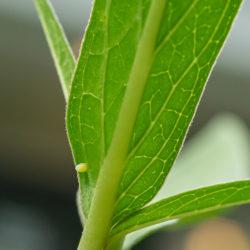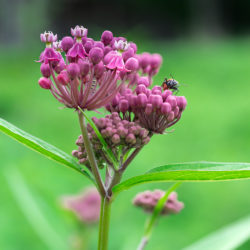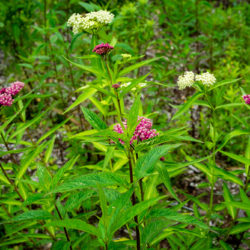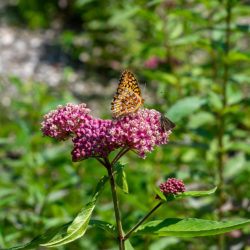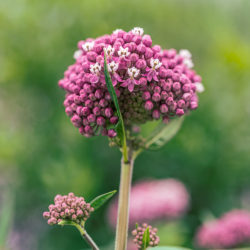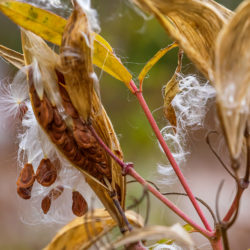Etymology
Asclepias is Greek for Asklepios, the god of medicine; incarnata is Latin for flesh-colored.
Native Habitat
Wet meadows, fields, swamps, and lake or pond margins in full sun to light-shade.
Garden Uses
Great for rain and/or butterfly gardens and naturalized in wet areas, such as pond edges. Tolerant of meadows that don’t dry thoroughly, especially in spring. One of the few perennials that can thrive in heavy, wet clay, although it prefers slightly acid to neutral soil pH.
Overview
A showy perennial herb topped with clusters of often rosy pink small flowers on erect leafy stems.
Leaves and Stems
Leaves are narrow, simple, green, hairless (glabrous), lance-shaped (lanceolate), opposite, and smooth-edged (entire). Size range is 2-3/4 to 6 inches in length, and 1/2 to 1 inch in width. They attach on individual short stems (petioles) to erect green stems 2 to 5 foot tall, open, and also hairless. Broken leaves and stems exude less milky sap than some of the genus.
Flowers
Bisexual, fragrant clusters or umbels composed of approximately 20 small flowers each. Each small flower is approximately 1/2 inch wide, with 5 reflexed petals around an elevated crown of 5 nectar cups, each with a smooth, curved horn inside. Petal color range includes white, pale pink, deep pink or purplish pink.
Fruit/Seed
Elongated, narrow, tan-brown seed pods, approximately 4 inches long, can persist through winter, but typically open to release numerous brown, flat seeds, less than 1/2 inch long, each on its own silken tent for wind dispersal.
Animal Associates
Attracts pollinators, especially bees, wasps, butterflies (including Monarchs) and hummingbirds. Bees land on the smooth horns within each flower crown, but their legs slip off and down into pollen areas. If their legs become too heavily laden with pollen, they may be trapped and die in place. Aphids are also inevitable on milkweed, but usually don’t affect plant health. Milkweed is deer resistant.
Propagation
Easily started from seed collected when pods are dry but unopened. Provide one month cold, moist stratification. Plant clusters can be divided in spring, but plants have long tap roots and care should be taken. Also plants are later to emerge than many.
Ethnobotanical Uses
Milkweeds are generally poisonous raw, but edible when correctly cooked.
Garden Location
Library Garden (see garden map)
Anecdotal Information
Some sources say Apocynaceae is now considered the flowering plant family, of which the sub-family of milkweed is now termed Asclepiadoideae*
Sources
Lady Bird Johnson Wildflower Center
USDA, US Forest Service, plant of the week: Swamp milkweed
Plant Profile by Kate O’Dell


